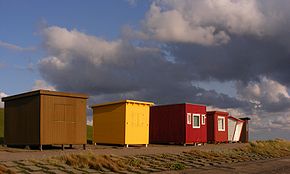Bathing place
A bathing shack is a small shack near a swimming area. Mostly wooden , it is used to store bathing accessories, personal items and to put on or take off swimwear . Bathing stalls differ in their size and equipment; there are both simple, small cabins that are only used for dressing, and larger huts that have interior fittings and electricity . Unlike bathhouses , they do not have their own bathing area inside, and unlike bathing carts , they are attached and are not moved into the sea.
Using the example of Dagebüll

In the North Frisian community of Dagebüll , bathing stalls have a long tradition that goes back to 1927. At the beginning of the bathing season, the stalls and the beach chairs are taken out of the winter storage and placed on the beach. The wicker beach chairs are placed on the grassed dike , while the bathing huts in front of it are anchored to the fixed dike foot. This protects them from flooding . The around 60 stalls are of different designs, differently colored, and shape the overall impression of the beach. Unlike beach chairs, which are mainly rented by tourists , they are only used and passed on within a family via inheritance law . Traditional law was introduced to limit the number of stalls.
The stalls, each measuring around eight square meters, usually have lockable exterior windows and seating inside. In bad weather , they protect against storms and rain. So some North Frisians let the day end there after a bath with Klönschnack and a Pharisee or Köm .
Individual evidence
- ↑ Ino: Small colorful heritage farms on the beach. In: The world. July 5, 2003, accessed June 14, 2020 .